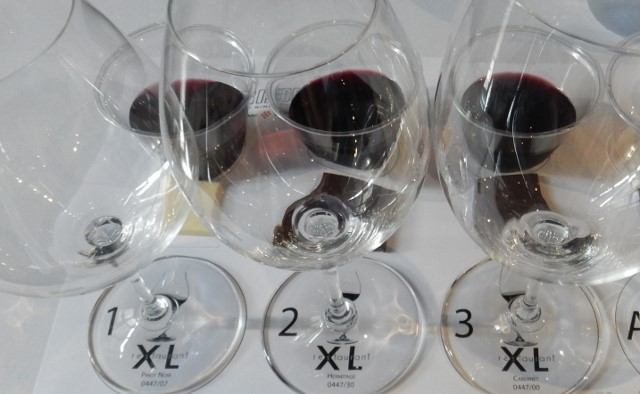“When we buy a bottle of wine,” says Georg Riedel of Riedel, the Austrian-based wine glassware company, “we get messages—from the label, the grape varietal, the region, the alcohol content. With these messages come expectations. Wine has romance, and a good bottle of wine has an elevation of expectation. Wine is too good not to share, and it is emotional. A bottle of wine is looking for a translator; the glass. If you don’t like the wine; it may not be the wine—it may be the glass.”
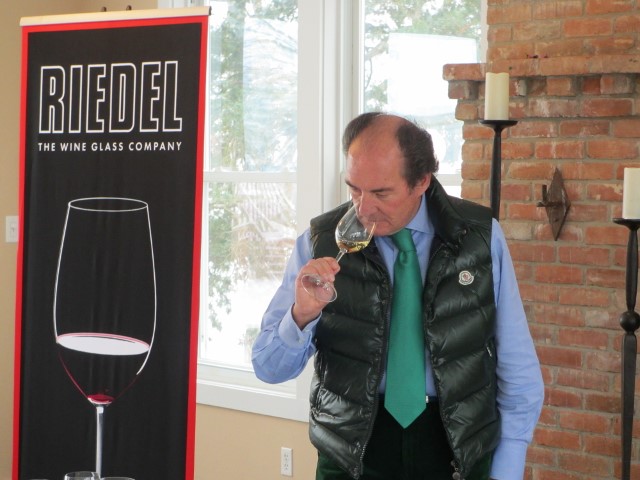
George Riedel, 10th generation glass maker (Photo, courtesy of Riedel)
One hundred and fifty or so consumers and people in the trade have gathered to hear Riedel speak on, and demonstrate the relationship between, wine and varietal-specific wine glasses. We’re seated at tables with a wine tasting placemat that includes three Riedel wine glasses from the Veritas glass series, one Riedel Swirl water glass, three red wine samples in plastic cups, and a bottle of cold water.
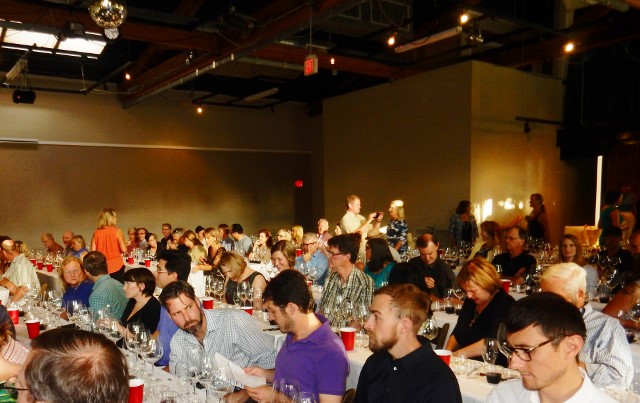
Participants prepare for tastings.
Test #1
In his first demonstration, Riedel asks us to pour 3-4 ounces of water into each of the three wine glasses: a Pinot Noir glass, a Hermitage glass (also for reds such as Barbera, Malbec, Mourvèdre, Sangiovese, Syrah Old World, and others), and a Cabernet glass. He asks us to take a sip, paying attention to temperature, the coolness of the water, and where we feel that coolness in our mouths. He points out that a glass makes you position your tongue differently; with the Pinot Noir glass, our tongues definitely curl back and the water is felt at the front of our mouths. The Hermitage glass has a smaller mouth and we need to tilt our heads back more; gravity moves the cool liquid to the back of the mouth. The Cabernet glass spreads the water, chilling our whole palette, and the coolness stays longer on the palette. The Cabernet glass made the best glass for water, but the point was to get us to see how glasses are tested and also to get us to note how the wine would be distributed on the palette.
Test #2
“Wine has color, aroma, and flavor,” Riedel says. “With wine, we use three senses; sight, scent and taste.”
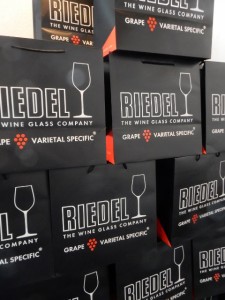
We empty the water from the glasses and equally distribute the wine from the first plastic cup between the three wine glasses. Riedel asks us to smell the wine in each glass by placing our upper lips against the rim of the glass. The scent in the Pinot Noir glass is fruit-driven, very earthy in the Hermitage glass and rather sour in the Cabernet glass.
We taste: a small sip, letting the wine sit in the mouth, testing for balance. In the Pinot Noir glass, this first wine is balanced and has a good fruity taste. In the Cabernet glass, the wine had a flat taste, and in the Hermitage glass, the wine tasted over-seasoned, salty and bitter.
“Same wine,” Riedel says, “You poured it yourself.” We’re not surprised to learn that the first wine is an Oregon Pinot Noir, but the marked difference between the glasses is unexpected.
Next, Riedel asks us to smell the wine in the second plastic cup. There’s no scent, and he tells us this is because there is too much air at the top of the cup. We taste it and I taste a lot of fruit, with some chocolate tones. The tannins are good as well. I like it. We pour this wine into the third glass, the Cabernet glass. He asks us to smell the wine. This time, the aroma is very nice. When we taste the wine, however, there are surprised groans—the wine is too acidic, too bitter.
Riedel nods, “A wet dog taste, yes?” The wine tasted better in the plastic cup, and Riedel is happy to laugh along with us. He’s a comfortable, experienced public speaker. He gives this talk perhaps 25-30 times a year, but the spiel is fresh, fun and informative.
“Pour the wine into the first glass, please,” Riedel says, and we pour the wine into the Pinot Noir glasses. The wine is terribly bitter. Finally, we pour the wine into the second glass, the Hermitage glass. The scent is great, the taste is crisp and fruity and the wine even has a better mouth feel than in any of the other glasses. The wine is a Washington Syrah and it was clearly the best glass for this wine.
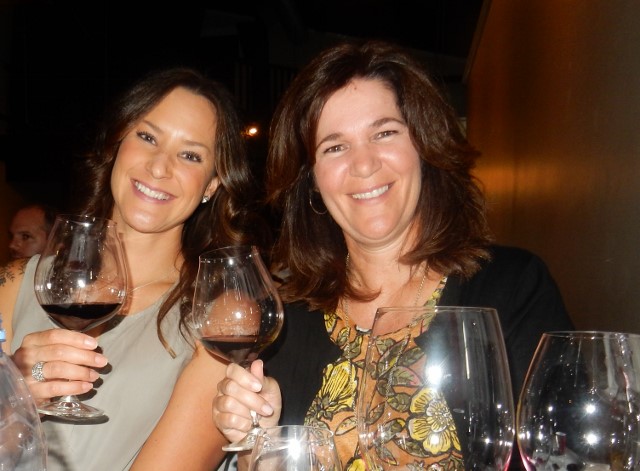
Pacific Northwest wines were as delicious as the glasses were beautiful.
Test #3
We look next at “tannin management,” and begin by pouring all of the wine from the third plastic cup into the Pinot Noir glass. While I like the wine, something is off, and there is a slight bitterness. We pour the wine into the second glass, the Hermitage glass, where there’s a nice, fruity scent. The taste however, is surprisingly flat. Balanced, perhaps, but flat.
We pour the wine into the third glass, the wonderfully cavernous Cabernet glass. Riedel reminds us that this glass “killed” the Pinot and the Syrah. We sip. There’s plenty of aroma, and no harshness. The mouth feel is terrific.
Yes, the third wine is a Cabernet and the Cabernet glass is definitely the right glass for the wine.
“This is why you need more than one glass. If you play golf,” Riedel says, “you have nine tools. If you are interested in wine, the right glass is simply a tool that makes a difference in the experience.”
An Eleven-Generation Company
Speaking with Georg privately after the talk, we discuss how the company has been making luxury glassware since Johann Cristoph Riedel started the business in 1756. Georg’s father, Claus Riedel, the 9th generation family member of the business, was the first to look at how the design of a glass affects the taste of the wine, developing the architecture of what we know today. Indeed, he can be called the inventor of the functional wine glass. Claus started working on this in the late 1950’s and introduced his Sommeliers line in 1973. Georg, the 10th generation member of the business, joined the company in 1974, and over the years has made many contributions. He’s designing product lines, extended the brand with the purchase of Nachtmann and Spiegelau, and helped the company grow internationally by working closely with the wine industry. He travels substantially throughout the year, referring to himself as a bit of a gypsy. “To be an entrepreneur is to be always reaching for what grows your business.”
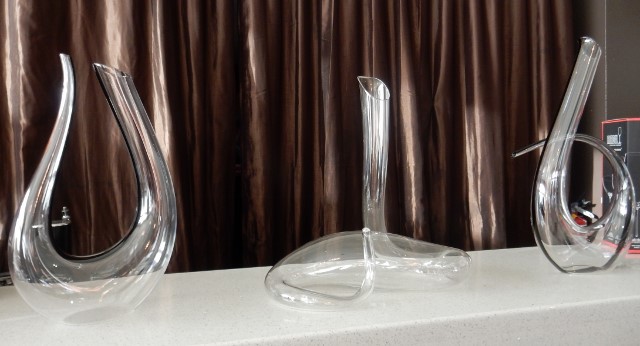
Riedel decanters.
Georg has in no way retired, but in 2013, he stepped aside as CEO and President, promoting son, Maximilian Riedel. Maximilian and Maximilian’s sister, Laetizia, the company’s attorney, represent the 11th generation.
The Right Tool Makes a Difference…and Magic
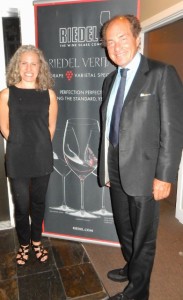
George Riedel with the author.
I have and enjoy using my own small collection of Riedel glasses, and not all of it imprinted with wine festival logos. I went into this believing the right glass can make a difference in a wine’s taste and aroma. I’m not, however, a militant wine snob; I know you will not burn eternally if you hand me a Pinot Noir in a Cabernet glass, or even in a paper cup. It’s far more important that a good wine is accompanied by good company. But I learned from Riedel’s demonstrations. Each demonstration was a magic trick of sorts—the wrong glass takes something away from the wine, while the right glass lends a better aroma, mouth feel, balance, and/or finish. Riedel removes the magician’s red cape, sharing the secret behind the trick—the right glass truly makes a difference in the enjoyment of the wine.
Take a look at Riedel’s wide selection of glassware and decanters. There’s some great information about wine wine tasting as well. Within the Riedel family, Nachtmann produces beautiful Bavarian crystal and Spiegelau is the name to look for in beer glasses.
For More:
- On our site: Everything You Need to Know About Prosecco
- On our site: Ice Wine: Nature’s Sweetest Mistake
-All photos by Nancy Zaffaro, except as noted.

